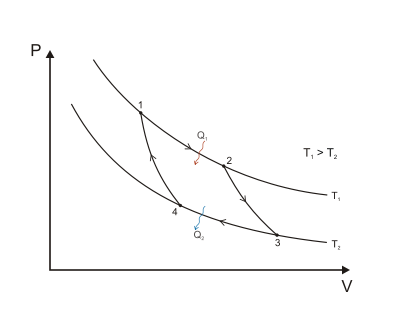The Carnot cycle is a particular thermodynamic cycle, modeled on the hypothetical Carnot heat engine, proposed by Nicolas Léonard Sadi Carnot in 1824 and expanded upon by Benoit Paul Émile Clapeyron in the 1830s and 40s.
A heat engine acts by transferring energy from a warm region to a cool region of space and, in the process, converting some of that energy to mechanical work. The cycle may also be reversed. The system may be worked upon by an external force, and in the process, it can transfer thermal energy from a cooler system to a warmer one, thereby acting as a heat pump rather than a heat engine.
The Carnot cycle is the most efficient cycle possible for converting a given amount of thermal energy into work or, conversely, for using a given amount of work for refrigeration purposes.
The Carnot cycle
The Carnot cycle when acting as a heat engine consists of the following steps:
- Reversible isothermal expansion of the gas at the "hot" temperature, TH (isothermal heat addition). During this step (A to B on Figure 1, 1 to 2 in Figure 2) the expanding gas causes the piston to do work on the surroundings. The gas expansion is propelled by absorption of quantity Q1 of heat from the high temperature reservoir.
- Isentropic (Reversible adiabatic) expansion of the gas. For this step (B to C on Figure 1, 2 to 3 in Figure 2) we assume the piston and cylinder are thermally insulated, so that no heat is gained or lost. The gas continues to expand, doing work on the surroundings. The gas expansion causes it to cool to the "cold" temperature, TC.
- Reversible isothermal compression of the gas at the "cold" temperature, TC. (isothermal heat rejection) (C to D on Figure 1, 3 to 4 on Figure 2) Now the surroundings do work on the gas, causing quantity Q2 of heat to flow out of the gas to the low temperature reservoir.
- Isentropic compression of the gas. (D to A on Figure 1, 4 to 1 in Figure 2) Once again we assume the piston and cylinder are thermally insulated. During this step, the surroundings do work on the gas, compressing it and causing the temperature to rise to TH. At this point the gas is in the same state as at the start of step 1.


0 comments:
Post a Comment